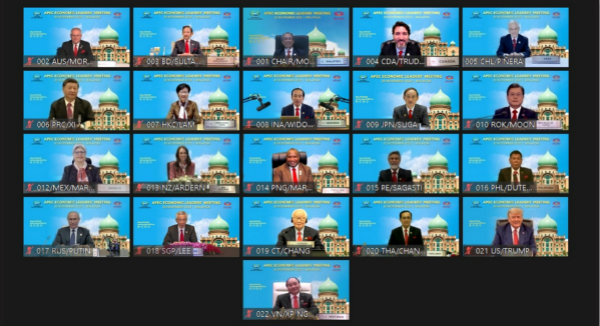APEC committed to regional growth

A screenshot shows participants of the virtual APEC Economic Leaders Meeting 2020 pose for a family picture, in Kuala Lumpur, Malaysia, Nov 20, 2020. [Photo/Agencies]
Asia-Pacific Economic Cooperation member's new growth vision will effectively advance regional trade and investment and will promote an open, dynamic and resilient regional community in the coming decades, officials and experts said on Friday.
The vision, APEC Vision 2040, announced during the 27th APEC Economic Leaders' Meeting via video link, is set to build on the success of the Bogor Goals and will chart long-term strategic direction for the region. It will replace the Bogor Goals and serve as the primary reference point for the region for the years to come.
As one of APEC's flagship initiatives, the Bogor Goals were announced in 1994 for members to move toward the long-term goal of free and open trade and investment in the Asia-Pacific no later than the year 2020.
The new vision will help economies in the region create a free, open and fair trade and investment environment, continue to support the multilateral trading system, boost regional economic integration and push the goal of achieving a Free Trade Area of the Asia-Pacific, said Yang Zhengwei, deputy director-general of the Department of International Trade and Economic Affairs at the Ministry of Commerce.
Led by the new direction, Yang said, APEC economies will be able to promote new formats in line with the digital economy. The new model will push involved parties to better participate or even lead global economic development in the digital era.
The 2040 vision continues the spirit of the Bogor Goals and makes a long-term commitment to the multilateral trading system, showing a firm determination to promote regional integration and seeking fresh momentum from areas such as the digital economy, he said.
According to the APEC Policy Support Unit, trade liberalization has progressed significantly in the APEC region during the implementation period of the Bogor Goals, with falling tariff levels seen.
China has made a huge contribution to the realization of the Bogor Goals, with its average tariff level dropping from 23.6 percent to 7.5 percent, said the Ministry of Commerce.
In the meantime, China's opening of its services sector has notably surged, and entry barriers for foreign investment have been significantly lowered or removed. The country has also sponsored international events such as the China International Import Expo to enrich global trade and investment activities.
As China and its partners managed to sign the Regional Comprehensive Economic Partnership earlier this month, and the country has sped up negotiations on the China-Japan-Republic of Korea free trade agreement with involved parties, China will play a key role in the region's economic recovery, said Zhang Shaogang, vice-chairman of the Beijing-based China Council for the Promotion of International Trade.
Guided by the new vision, APEC economies will be able to further advance the regional trade and investment agenda, as commitment to the pursuit of free and open trade and investment are made more imperative during these difficult times, said Liu Chenyang, director of the APEC Study Center at Nankai University in Tianjin.
This highlights the willingness and conviction of many economies in the region to continue to confront the threats of protectionism and unilateralism in whatever form they may occur, said Shen Minghui, a researcher at the Chinese Academy of Social Sciences.
There are already signs of recovery around the APEC region, especially coming from economies that were able to curb the spread of the virus early on and have reopened their economies, as well as improved manufacturing activities, according to the APEC Policy Support Unit.
The views don't necessarily reflect those of Qiushi Journal.
























